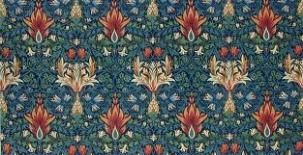This next brief was moving on from image and was all about typography.
So what is typography?
I could be the management of letters, a means by which an idea is written and given visual form or simply just painting with words. There are a multitude of ways in which people define what typography is.
The advances in politics, economics, society and technology has helped typography to evolved but ‘Cunieform’ script is one of the earliest known ways of writing, made with wedge-shaped marks on clay tablets. Also, different art movements had different typography characteristics, for example, Art Nouveau used flowing forms and handmade letters, Dadaism used mostly Sans Serif and contemporary work is all about vast experimentation.
Once establishing what Typography is I looked at the history of 4 typefaces: Gill, Clarendon, Palatino and Franklin. Here is what I found and learnt:
Next I looked at letter spacing and how words/sentences should be laid out to ensure smooth reading. I had to ensure an overall balance whether nothing jumps out and is distracting.
Once looking at letter positioning and the history of 4 typefaces I experimented with those typefaces to create some ‘interesting’ layouts to help go towards a poster of one of them. Altogether there were 32 squares, here are just a few of them:
Initially I thought this would be a lengthy process however I think it really helped me to realise how much you could experiment with just one letter and the variety of different ways you could represent it. I think some of my outcomes are successful however I think I could have played it less safe and really pushed it further, for example cutting letters up perhaps!
Next we moved onto Expressive Personality Typography. My partner for this exercise was a girl from the 3rd year called Sun. I learnt that she was from South Korea, she studied business, she also studied interior design in Paris for seven years, she like reading, drawing, story writing and doing yoga and is 25 years old. From this the words I gathered to describe her were Cultural, Calm and Competent. These are some initial experimental ideas I did:
For these I tried using biro pen, ink and charcoal as well as different techniques such as blending, daubing and using repeated lines. I felt that the outcome didn’t need to be too bold as I said she was calm, is need to be quite flowing to show her capability and there needed to be some sort of contrast to show her interest in different cultures (travelling). My best outcome was this:

I found this outcome the most visually interesting however i’m not sure if it represented my parter as well as it should have. I’m happy that I presented it vertically instead of typically horizontally as I think it helped to stand out a little more and i’m happy with the blending and the shape of the cut off letters. Unfortunately I feel that it doesn’t quite fit Sun’s character, which I think my lecturers would agree. I think that the contrast within the blending manages to represent the cultural side of her and her interest for travelling around. Also, the smooth brush strokes reflect her calm personality. Even though I liked the unfinished letters I don’t think this helps to show that she is competent and think it may in fact imply that she is forgetful perhaps. Finally I think that the letter edges could be a little too harsh as she enjoys calmer, more relaxing past times such as reading and yoga, maybe a softer or curlier touch may have implied this more clearly. I feel that if I had experimented further with my previous designs above and had had more options to choose from it would have helped me to decide on a better outcome.
The next part of this project was to create a Hybrid Font, so I began by choosing a significant story that happened in my childhood. I came up with ‘Vanity causes baby sister’s self mutilation’. This came about from when my sister and I were younger playing in the bathroom together. I was looking in the mirror when my mum came in to find my sister’s face covered in blood! She had mistakenly shaven her face with mum’s razor…and still has small scars on her nose and cheek. Looking back now the story is quite funny however the written down now it also sounds quite dark/serious therefore it becomes more ironic. I aimed to use a more playful typeface to contrast the seriousness and to insure the viewers realise that there is a twist and it isn’t horrific.
I began by experimenting with typefaces in magazines and cutting up and matching various letters:
I found doing this by hand and having to look for different typefaces in a magazine a pretty good way to start experimenting as I had to think quite carefully about sizes and which would fit together well. Of course some worked better than others! The two I particularly liked were ‘M’ and ‘R’. I managed to get the sizes pretty similar and they fit just right. The M was very flowing and the curl could possibly fit my story to create the irony of the sinister story. However I also like the really strong contrast on the R as it could represent the fun and sinister side all in one.
As I wanted my final outcome to be digitally done I moved on to experimenting digitally. I chose to apply different typefaces to just one word to start with:
I think apart from the ‘I’ and the ‘Y’ they worked ok.. however none of them were quite right yet. I think that for my story the curly serif fonts would work well however I don’t think there was enough contrast between any of the typefaces yet.
This ‘LF’ example shows that i’m beginning to get further towards what I feel my outcome should be like. I decided to definitely use a sans-serif and serif font to keep the contrast strong. However this is still implying that it is just a sinister story as the serif font is too sharp and jagged. I decided to use the sans serif font but introduce something else more playful.
Here are the layout options of my final outcome:
I found that because most of the words were quite long not many words fit onto a line so laying it out landscape worked best.
Words in the environment was the final part of this project. I was given the words ‘Calm and Storm’ and was asked to use the environment to express them. I wanted to think a little further than the obvious, such as candles reflecting CALM. I came up with various ideas for calm: glitter, music, chocolate, tea leaves, reading, rose petals and sand. On the other hand I came up with: crushed ice, makeup on the mirror, condensation, fire, smashed china, leaf rubbings and sand for STORM.
Here are some of my outcomes:
These are experimental outcomes therefore don’t look as finalised as final outcomes. However I feel that it helped me to look closer at the beauty in my environment and how I could use it to express my graphics work, not just for this but for future work. I think they all worked quite well however the ‘coloured crushed ice’ to reflect storm didn’t turn out quite as I wanted as the ice began to melt, so unfortunately it looks a bit like jelly or sweets.
I really enjoyed working on this ‘word’ brief as I feel we got to experiment and learn about lots of different aspects of typography. Using typography to express someones personality and cutting up different letters to create new personal typefaces was another interesting insight into what more I could do with typography.
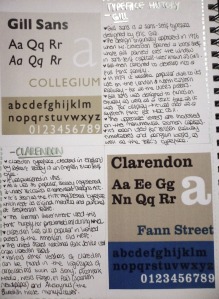
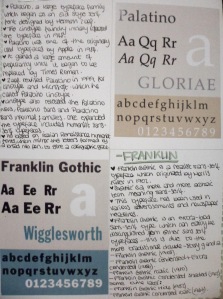




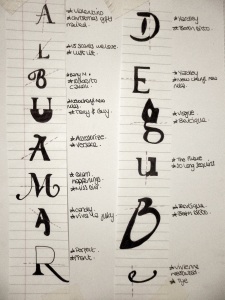
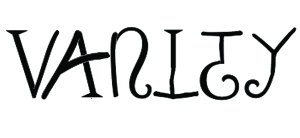


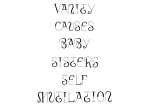



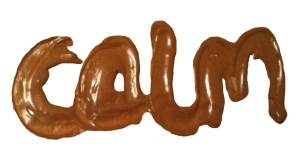
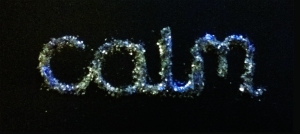
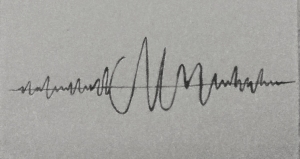
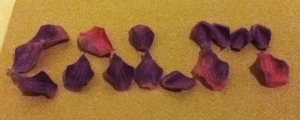













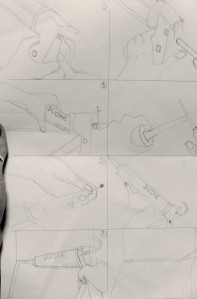


 2.
2.




